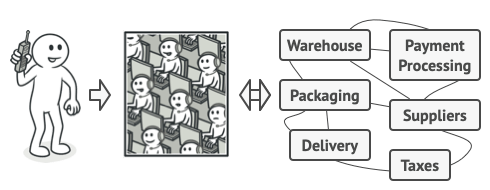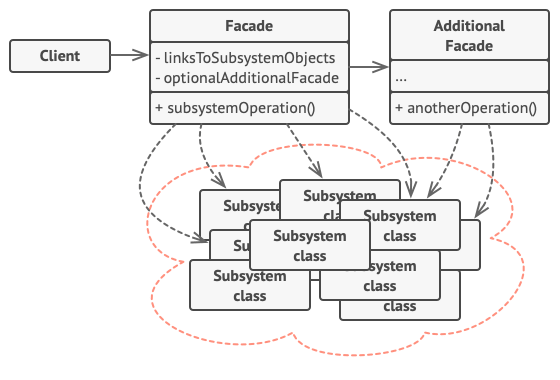Facade 外觀模式 外觀模式(Facade Pattern)是一種結構型設計模式,它為子系統提供一組統一的接口。這個接口使子系統更容易使用。
結構
Facade: 提供統一的接口,並且知道如何將請求傳遞給子系統的相應對象。
Additional Facade: 可以有多個外觀,這取決於系統的複雜性。
subsystem: 這是子系統的一組類,它實現了子系統的功能。子系統並不知道外觀的存在。
範例 假設我們要設計一個「飯店預訂系統」,其需求包含:
檢查房間是否可預訂
預訂房間
進行付款
記錄與維護顧客資料
內部子系統可能包含:
RoomService:與房間相關的業務(檢查房間可用性、預訂、取消等)
PaymentService:與付款相關的業務(信用卡或其他支付方式)
CustomerService:與顧客資料維護相關
重構前 RoomService
1 2 3 4 5 6 7 8 9 10 11 12 public class RoomService {public boolean isRoomAvailable (int roomNumber) {"Checking availability for room: " + roomNumber);return true ; public void bookRoom (int roomNumber) {"Booking room: " + roomNumber);
PaymentService
1 2 3 4 5 6 7 public class PaymentService {public boolean pay (String customerName, double amount) {"Paying " + amount + " for " + customerName);return true ;
CustomerService
1 2 3 4 5 6 public class CustomerService {public void addCustomer (String customerName, String contactInfo) {"Adding customer: " + customerName);
客戶端程式(未使用外觀模式)
1 2 3 4 5 6 7 8 9 10 11 12 13 14 15 16 17 18 19 20 21 22 23 24 public class ClientWithoutFacade {public static void main (String[] args) {String customerName = "Alice" ;String contactInfo = "alice@example.com" ;int roomNumber = 101 ;double amount = 2000.0 ;CustomerService customerService = new CustomerService ();RoomService roomService = new RoomService ();boolean available = roomService.isRoomAvailable(roomNumber);if (available) {PaymentService paymentService = new PaymentService ();boolean paymentSuccess = paymentService.pay(customerName, amount);if (paymentSuccess) {"Room booked and payment successful!" );
缺點
客戶端必須了解並直接操作 CustomerService、RoomService、PaymentService 等多個類別。
程式碼分散在客戶端,當要新增或修改預訂流程時,勢必會影響各個呼叫邏輯。
耦合度高,客戶端需要了解不同子系統的順序、參數與各種細節。
重構後 HotelFacade
1 2 3 4 5 6 7 8 9 10 11 12 13 14 15 16 17 18 19 20 21 22 23 24 25 26 27 28 29 30 31 32 33 public class HotelFacade {private CustomerService customerService;private RoomService roomService;private PaymentService paymentService;public HotelFacade () {this .customerService = new CustomerService ();this .roomService = new RoomService ();this .paymentService = new PaymentService ();public boolean bookHotel (String customerName, String contactInfo, int roomNumber, double amount) {if (roomService.isRoomAvailable(roomNumber)) {boolean paymentSuccess = paymentService.pay(customerName, amount);if (paymentSuccess) {"Book hotel and payment successful!" );return true ;"Booking failed!" );return false ;
客戶端程式(使用外觀模式)
1 2 3 4 5 6 7 8 9 10 11 12 13 14 15 16 17 public class ClientWithFacade {public static void main (String[] args) {String customerName = "Alice" ;String contactInfo = "alice@example.com" ;int roomNumber = 101 ;double amount = 2000.0 ;HotelFacade hotelFacade = new HotelFacade ();boolean result = hotelFacade.bookHotel(customerName, contactInfo, roomNumber, amount);if (result) {"Enjoy your stay!" );else {"Sorry, we could not book your room." );
優點
客戶端只需要了解並操作 HotelFacade 這個統一介面,不需要了解內部子系統的細節。
程式碼集中在 HotelFacade,當要新增或修改預訂流程時,只需要修改 HotelFacade 即可。
降低耦合度,客戶端不需要了解不同子系統的順序、參數與各種細節。
提高了安全性,客戶端無法直接操作子系統。

